This year, I had the privilege of speaking at Railvolution in Washington DC. I was selected to a panel that included David Alpert & Matt Johnson of Greater Greater Washington and was moderated by Jeff Wood better known on the web & in blogging circles as, The Overhead Wire. For me, it was an honor to be sitting at the same table as these folks considering that they have all been at it longer than me and are generally who I have looked up to when it came to forming my blogging voice.
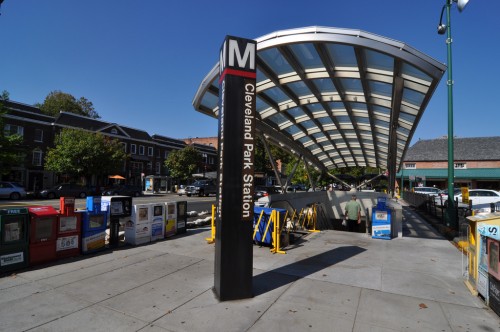
I was only able to attend the conference the day that I was speaking. The rest of my stay was spent playing tourist in our nation’s Capitol and as such, gave me a great perspective on DC itself. Now, I went in knowing that DC has great urban form but I don’t generally associate DC with great urban form when I play the word association game. I have been trained over the years to fear the Beltway traffic and indeed, looking at a map one can easily spot the standard American flavor suburban sprawl.
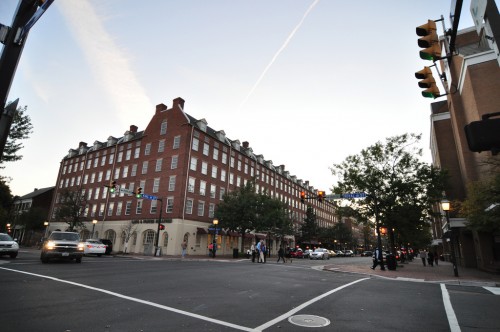
However, I was not really prepared for what I witnessed in person. My family and I stayed in Alexandria, VA which is SW and across the Potomac from DC. It has a couple of Metro stations which we took advantage of, as well as it’s own bus system and a free trolley on King Street, it’s tourist boulevard. We spent a couple nights exploring Alexandria since it was easy for us to walk around and very accessible to us since we stayed there.
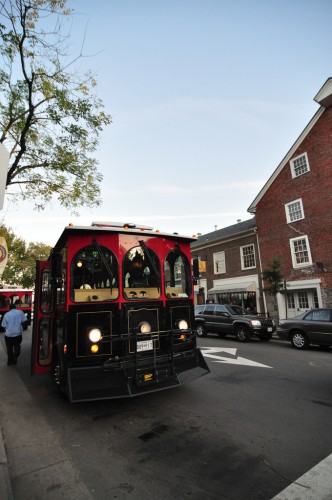
While I would consider Alexandria a burb of DC, it still presented a FANTASTIC built urban form. For you locals, this must be where Jim Brainard went when he decided how he wanted to transform Carmel because the similarities to the Arts District along Main Street in Carmel and Alexandria are striking.
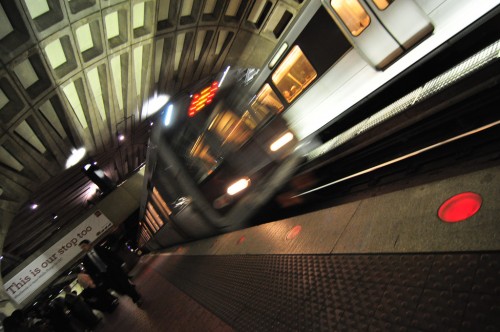
We also travelled into DC on the Metro a couple of days. The Metro itself is quite simple to use. We bought daily fare cards which when I look at the price, seemed pricey; it was $9 for a single day card. In contrast to that, we spent $22 each for an entire 7 day pass on Trimet in Portland when we visited last year. However, I was intent on experiencing the Metro and it did not disappoint! A smooth, swift and convenient ride was provided and we never waited more than 10 minutes on a train even during off peak time. It was nice to NOT be checking a schedule and instead be nervous that the train was going to show up before I had a chance to double check which direction we were suppose to be headed. Additionally, I want to take a moment to recognize the type of people using the metro. There were handicapped people. Dishevelled looking folks. People talking to themselves. There were young kids with their parents. Teenagers. Hipsters. Military folks. Government workers. People in business suits & skirts. Yes, ALL MINGLING ON THE SAME TRAIN AND RUBBING ELBOWS WITH EACH OTHER; a concept I point out simply because this seems like a foreign concept to most Indy residents, suburban and inner city, who vocally oppose transit spending here in Indy. (ie: “white lighting down from the suburbs” or “hoodlums walking around Fishers“)
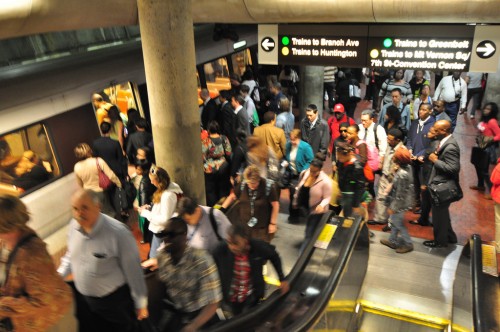
For my part, none of this bothered me at all. Maybe I am naive or conditioned to it now that I have studied and experience so much public transit in the past few years but I would be remiss to not point out the melting pot occurring on the trains and buses.
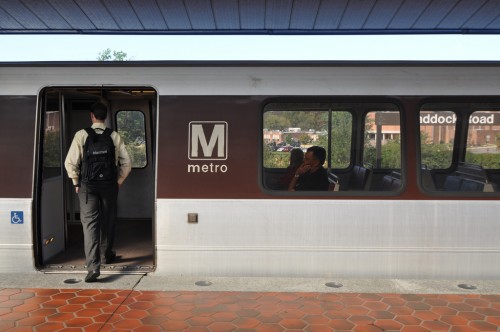
Once we got to DC, the built form there was fantastic. Sure, the area around the White House is mostly park land and it was unfortunate to see that the Reflecting Pool was all dug up (something I still need to check up on and see what they are doing). However, we visited the George Washington University area. This place was crawling with people and home to a vast outlay of dense buildings with ground level retail. We went into Whole Foods to get some eats and had to wait in a que line to get to the register. Overhead, there was a digital readout announcing when it was your turn.
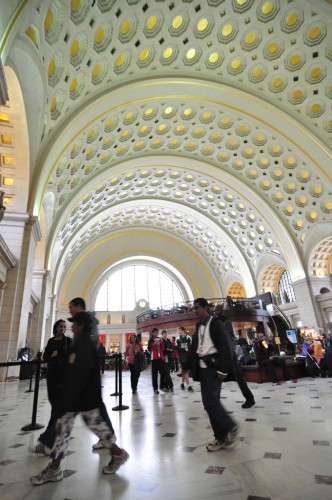
We visited Union Station where it is still used as *gasp* a real train station. There were many folks coming and going on regional as well as Acelea trains. The rest of the place resembled closely an urban shopping mall with many places to dine as well as retail shops. I ventured outside and saw the new DC bike hub which works much like our local hub. They have mechanics on staff to work on bikes as well as a parking facility and some lockers inside of it. It was very tastefully built and well used when we visited.Â
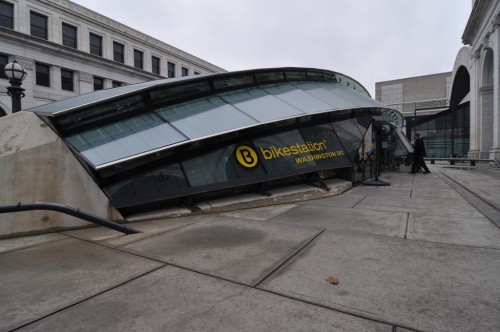
We visited the Smithsonian Zoo which was unique in that we simply walked in. No attendants taking tickets. Parking itself was QUITE limited and even on the Zoo website they encourage usage of public transit to get there; a suggestion it appeared a lot of people had taken.
We drove down H Street where a streetcar project is being planned. Tracks were embedded into the street ahead of actual service which to me, looks like prudent planning on the part of local planners. I cannot wait to see this project in action!
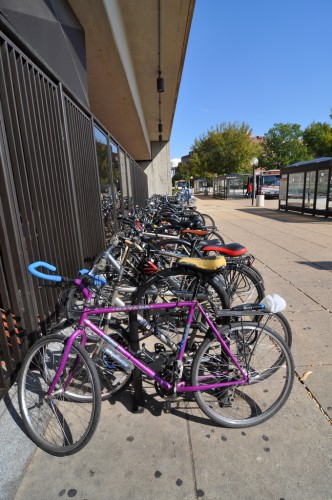
In conclusion, we did not have nearly enough time to see and experience DC while we were there. It would be nice to have another week to see monuments and experience the vast array of urban spaces. But the time I spent there left me wanting much more of it and renewed my sense of vigor when approaching our local transit initiatives.
Really, you are going to use D.C. to justify transit here in Indy? Even my eight-year old daughter (on my second and her first visit to D.C.) knew that there was no comparison between the two. Oh, and ticket prices are high because they are broke.
A few tidbits:
#1: The comment about criminals going to Fishers will happen. It has happened in Philly at least once, where punks kids from another part of town descend upon some other area of town they don’t live in nor really need to go to. It also happened up in Minneapolis at a mall, where a mini fight riot and flash mob shoplifting spree occurred, and police said mass transit brought in the criminals in that incident.
#2: I just got back from a trip to NYC. First time I’ve been in 20+ years. I was at a younger age back then, so only remember bits and pieces. After years of seeing Hollywood takes on subways and stories about NYC, I was worried about the system. A former NYPD transit officer who post on a travel forum wrote a very detailed post about the NYC transit system and assure people it was for the most part safe (no where is 100% safe).
So we got our 7-day unlimited ride MTA cards. The system was simple to use, even though the machines had issues reading my credit card. After finally understand the subway system (didn’t take long), I will say it is a nice system. I did ride a train in Chicago once, but back then I didn’t think about things like mass transit, so it didn’t leave that big of an impact.
The first thing is that the system is sometimes packed, really packed. Overall I noticed your best course of action is to just pick something and stare. Don’t make eye contact with some people, because some folks will sometimes take issue and are just waiting for a confrontation “YOU SEE SOMETHING YOU NEED!” “YOU GOTTA PROBLEM?” Definitely an issue, though a very, very small issue. I’ve heard that NYPD cops are usually all over the NYC system, however given OWS, it appeared to me that those cops were likely pulled as the financial district had a lot of cops out and about just standing around.
Overall, the system is a nice system and we need a better transit system here in Indy. However, rail isn’t what Indy needs and any plan that includes rail wouldn’t be supported by me. NYC density is around 27,000 people per square mile. Indy density is around 2,273 people per square mile. We don’t have the density for rail at all. Even if you look at Fishers and Lawrence, two municipalities where the rail is claimed to be needed, the density is 1,949 and 1,938 respectively.
A rail system will be a billion dollar boondoggle for those who fund it. The way the money/costs is just brushed off as no big deal makes me figure our elected “leaders” no longer stand on principle. With more and more municipal bankruptcies being filed all over the country, I sometimes wonder if they just don’t care about the future of our local governments and plan to build it, then default on the bonds?
I won’t support a tax hike for rail. NYC needs its rail. Chicago needs it rail. Indy needs a very, very stepped up bus system, which includes rapid/express buses.
For the guys who run this site: is there a book or two about urban transit that you might recommend for reading, one that perhaps studies why systems have worked and which ones haven’t?
I ask because I’m just a curious business guy who will always opt for rail when traveling, but for every packed Metro train in DC there is the experience I just had mid-day on Seattle’s new light rail ($2.25 which seems ridiculously low considering the current $8.50 fare on SF’s BART): perhaps 30 people on the entire line from downtown to the airport. I’d just like to learn more to help form my own opinion about what might be a desirable mix for Indy.
And maybe it’s just the crazy consultant in me, but I just have to wonder if perhaps Indianapolis could/should/must create an urban transit model that doesn’t just mimic what exists in other cities, but invent an entirely new solution that might advance the possibilities of urban transit in second and third-tier cities.
It’s great to look to existing models, but sometimes the most significant innovations actually result from looking outside the traditional sources and starting with a provocative premise or a disruptive hypothesis that is a catalyst for a different type of solution. This is addressed nicely in the new book Disrupt by Luke Williams: http://www.disruptive-thinking.com/
I know of no specific book. Besides, it would likely be outdated 5 years after it was published. As we learn more about how our auto-oriented planning has skewed transit planning, we better define how to build systems. Not only that, planners could design something perfectly, and then a politician might enter the room and get made that his town or neighborhood was not included. then, the plan takes a skew and what may have been good for the region is now not as good for region but at least one politicans constituents were served.
.
There will always be conflicting camps about how to properly design a system. Should it serve only jobs? Should it be constructed in the cheapest way at the sacrifice of potential riders? So many different ways to define “the best way”
Interesting article here (in terms of some of the questions raised in the comment section) about the recent ridership report for the transit system in Minneapolis. http://www.startribune.com/local/minneapolis/132361383.html
I believe the issue with ridership is in the planning details. Many systems have taken an approach that if you place a station anywhere, development will occur. Locating a station near many vacant lots will not garuntee development. You must already have a base ridership from the surrounding community. Also, we must truly plan on providing trips for employment centers. While it would be great taking a train to LOS for a football game, that is once a week, 8 or so times a year. People make trips to work and back 5 times a week all year long. If you create a transit line that runs to a corn field where a new development is supposed to occur or is planned, you may not see ridership from that decision for many many years. Locate transit corridors and stations near proven ridership numbers and places with existing infrastructure to get to the stations and the system will have a much greater chance of early success and further development.
A train serving LOS would also serve numerous major employers, so that’s probably a bad example of a train to nowhere.
That’s why Indy needs to think small to be progressive because the current density and suburban culture doesn’t help the case for transit connecting downtown with Fishers or Carmel. Rather, Downtown needs to be connected only with Broad Ripple, Irvington and the Airport initially. If Indy would just focus on Washington Street and College Avenue, where density already exists and future development will become more prime with increased gas, then the general public will become more comfortable with spending money on a system that actually REBUILDS INDIANAPOLIS (from in to out). The suburbs can pave their own way to downtown when they feel fit—whether it’s 10 years later…or 50. This is the only way to pragmatically develop Indy into a more livable, semi-urban environment. You can’t expect a huge influx of residents and business wanting to invest here when all you see is road construction…on roads that don’t even need fixed. To me, that’s a waste of future transit infrastructure.
Micah, I’d argue that it’s merely pragmatic and sensible to focus on one N-S, and one E-W rail line inside Marion County. It’s where people already ride transit and where there’s density enough to support some form of rail…and where zoning and opportunity already exist for redevelopment.
In addition to the N-S and E-W line within the county, which I also agree should be along College Avenue and Washington Streets, perhaps a Portland-esque streetcar could be used as a circulator for the downtown, perhaps touching Mass Ave, Fountain Square, and Indiana Avenue/IUPUI with a connection with a centrailized bus hub somewhere along the line. In my opinion those should be the first steps.
One of my wife’s biggest complaints about going from downtown to Fountain Square (or downtown to anywhere outside 65/70) is the underpasses. They are dark and devoid of attractive features. If you passed underneath them in a streetcar, that would pretty much fix the problem.
.
It is really unfortunate that our downtown go cut off from formerly great neighborhoods like the Old Northside, Bates-Hendricks, Sacred Heart, Holy Cross, Cottage Grove, and Fountain Square, but a streetcar could really do a lot to remedy that.
I agree with your wife, and I think most of the “urban community” agrees that highways running through downtown are barriers to downtown development.
I will get a bit off mass transit topic here, but I have been thinking about this crazy idea and what would happen if we shut down I-65 from let’s say 21st St exit to the point where it merges into I-70. Would traffic get so bad that it would be unbearable or would people adjust quickly and it would not be that noticeable? Ever since NYC’s High Line, I thought about good urban solutions to closed and elevated stretches of highway running through downtown (vs. just demolishing them). This stretch could be converted into a green walkway, mid-rise buildings on the sides of the highway with easy access to “green high-line”….just brain-storming here, and I am not an expert on traffic, construction or urban planning, so I don’t know if this idea is really feasible…
I had some time to kill before a meeting last week and drove under a couple of the underpasses. The one on Penn is being painted white. The Cultural Trail goes alongside Capitol to South. Delaware was spruced up when Conseco Fieldhouse was built (mural, lights) and it doesn’t seem too gloomy. That leaves the long stretches under Union Station at Meridian and Illinois; surely those will be cleaned up before the Super Bowl.
.
Likewise there has been significant improvement to the underpasses at E. 10th & Mass Ave where the Cultural Trail meets the Monon, and to those on Market Street.
They aren’t done, but the Virginia Ave parking garage/train viaduct stretch by Conseco is looking really nice with the new lights. They haven’t uncovered them, but the plan for the lights in the ground sounds pretty cool too.
.
Definitely an improvement, but unfortunate it had to ever happen.
.
The biggest stroke of luck Fountain Square ever had was the fact that Virginia Ave runs on an overpass instead of under.
JP,
Obviously all of us on here would promote the eventual removal of urban interstates as barriers to neighborhhods, whether that be demolition or reuse. Having a green park in its place would more than likely be awesome and unusual, but the resulting traffic situation, without alternatives, would be a bad for both the transportation folks and the people living in the area. Dumping that many ADT onto area roads would have Public Works folks salivating at the opportunity to widen many surface streets. Also it seems that many people would be forced to use 465 when passing through and of course INDOT would realize that their short sighted planning efforts to widen 465 would be met and they could again start a self employment project that lasts decades and costs upwards of $1B. But, the idea of the green line is cool.
I realize that there are two key factors that you need to consider when closing/demolishing/moving a highway: (1) will people/freight continue to move quickly? and (2) what’s the cost of doing it?
No two cities are alike, but there are some successful examples of cities closing urban highways, where traffic was able to adapt (and absorbed by city streets), and neighborhoods around it flourished — e.g. SF’s Embarcadero Freeway project comes to mind.
I don’t know what is the percentage of through-traffic on that stretch that could be send outside of the city (I-465), but that would be important consideration. Obviously, building a new highway is more costly than maintaining or widening the existing one. I-465 will have to be widened again eventually under the current conditions. As a matter of fact, you can say that about almost every highway in our city since the growth of suburbs is outpacing the growth of the city. Closing I-65 stretch might mean it would have to be widened sooner. But you have to look at the positives as well. If the neighborhood develops, near Northside finally connects wit the rest of downtown, higher density, more businesses…..at the end it might be cost neutral from the city’s perspective.
I look at it the opposite way: those embankments (where the road is not on viaducts) present a major greening opportunity. Instead of grass and weeds, there could be native plantings, trees and trails at the “foot” of the Interstate between 21st and 11th, along much of I-65/70 between the splits, and along I-70 south of downtown. Keep Indianapolis Beautiful has already done quite a bit.
.
The internal combustion engine and the automobile will be with us for at least the rest of our grandchildren’s grandchildren’s lives (for the number-crunchers, four or five more generations). The infrastructure for automobiles and trucks will need to last another hundred years, too. As Joe points out, we can’t give INDOT and their contractors any excuses to build more lane-miles instead of fixing what we’ve got.
.
Ultimately, if part of the ROW needs to be re-purposed, then busways and rail lines would be the right uses.
Can you imagine what a nice high speed rail bed an interstate would make? It already connects pretty much all major cities. Just need to boot all the cars, lay some track, and string some wire.
Also See new Blog Post from Sustainability: Science, Practice, & Policy — “Railvolution Hits Washington, DC”
http://ssppjournal.blogspot.com/2011/10/railvolution-hits-washington-dc.html